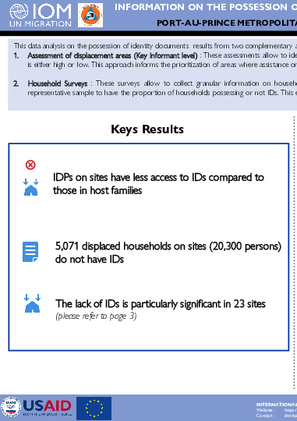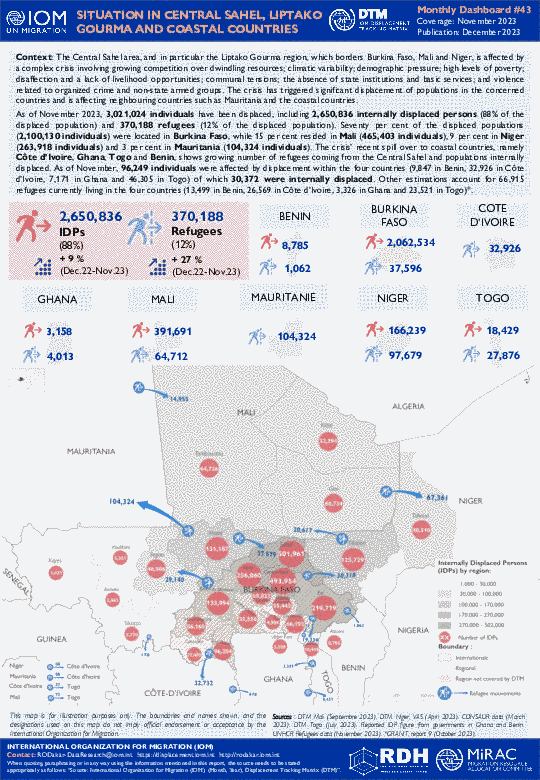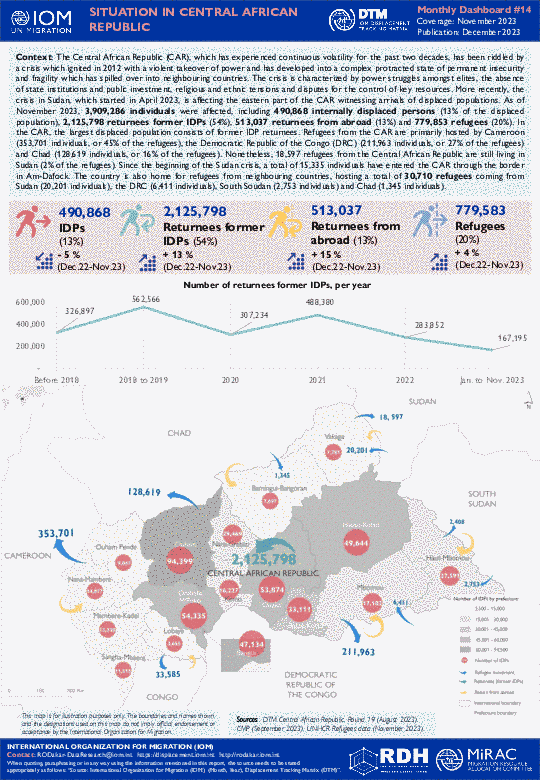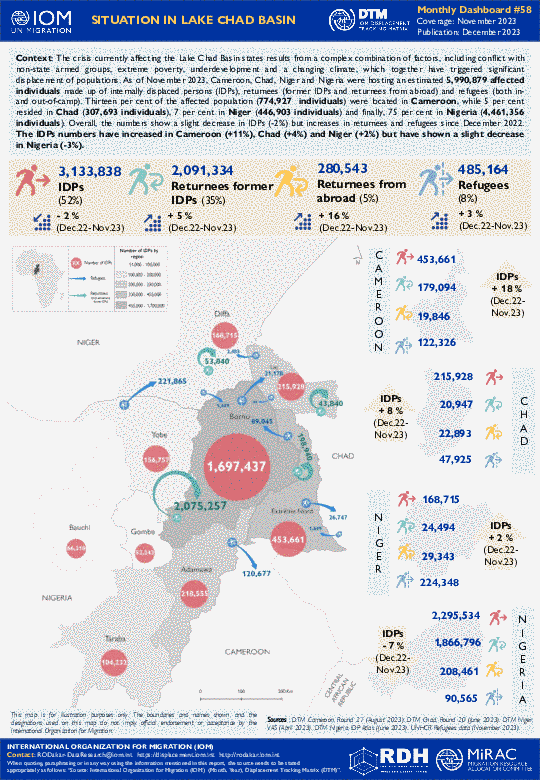-
Countries
-
Data and Analysis
-
Special Focus
-
Crisis Responses

Contact
dtmhaiti@iom.int
Language
English
Location
Haiti
Period Covered
Dec 02 2023
Dec 08 2023
Activity
- Mobility Tracking
- Event Tracking
Since the beginning of December, armed clashes have broken out in the neighborhoods of Bon repos - Lizon, Galette - Roche Blanche, Meyer and Guedon located in the municipality of Croix-des-Bouquets. In addition to loss of life, these attacks have also caused the displacement of approximatively 567 individuals (158 households). Most of displaced persons (78%) took refuge in host families and 22% in two newly created sites in the municipalities of Tabarre and Delmas

Contact
DTM Haiti, dtmhaiti@iom.int
Language
English
Location
Haiti
Period Covered
Oct 09 2023
Oct 20 2023
Activity
- Survey
- Mobility Tracking
- Site Assessment
- Baseline Assessment
- Village Assessment
This data analysis on the possession of identity documents results from two complementary approaches: 1. Assessment of displacement areas (Key Informant level) : These assessments allow to identify areas (host families and displacement sites) where the possession of identity documents (IDs) is either high or low. This approach informs the prioritization of areas where assistance on IDs’ issuance is most needed. 2. Household Surveys : These surveys allow to collect granular information on household level. Whereas the first methodology informs prioritization of areas, surveys allow from a representative sample to have the proportion of households possessing or not IDs. This eventually allowing to define the number of potential beneficiaries of assistance of IDs' issuance.
Results indicate that IDPs on sites have less access to IDs compared to those in host families, 5,071 displaced households on sites (20,300 persons) do not have IDs, the lack of IDs is particularly significant in 23 sites
The Central Sahel area, and in particular the Liptako Gourma region, which borders Burkina Faso, Mali and Niger, is affected by a complex crisis involving growing competition over dwindling resources; climatic variability; demographic pressure; high levels of poverty; disaffection and a lack of livelihood opportunities; communal tensions; the absence of state institutions and basic services; and violence related to organized crime and non-state armed groups. The crisis has triggered significant displacement of populations in the concerned countries and is affecting neighbouring countries such as Mauritania and the coastal countries.
As of November 2023, 3,021,024 individuals have been displaced, including 2,650,836 internally displaced persons (88% of the displaced population) and 370,188 refugees (12% of the displaced population). Seventy per cent of the displaced populations (2,100,130 individuals) were located in Burkina Faso, while 15 per cent resided in Mali (465,403 individuals), 9 per cent in Niger (263,918 individuals) and 3 per cent in Mauritania (104,324 individuals). The crisis’ recent spill over to coastal countries, namely Côte d’Ivoire, Ghana, Togo and Benin, shows growing number of refugees coming from the Central Sahel and populations internally displaced. As of November, 96,249 individuals were affected by displacement within the four countries (9,847 in Benin, 32,926 in Côte d’Ivoire, 7,171 in Ghana and 46,305 in Togo) of which 30,372 were internally displaced.
Contact
dtmlebanon@iom.int
Location
Lebanon
Activity
- Mobility Tracking
- Baseline Assessment
Period Covered
Oct 10 2023 -Dec 05 2023
Since October 8 there has been an increase in cross-border incidents between Israel and Lebanon, resulting in the displacement of people both within the South and elsewhere within the country. Since October 10, the Displacement Tracking Matrix (DTM) has been conducting the daily monitoring of population movements. The objective of the exercise is to inform preparedness and response planning.
Population Groups
IDPs
Survey Methodology
Unit of Analysis Or Observation
Admin Area 2
Admin Area 3
Household
Individual
Type of Survey or Assessment
Key Informant
Keywords
Geographical Scope Full Coverage
Administrative boundaries with available data
The current dataset covers the following administrative boundaries
The Central African Republic (CAR), which has experienced continuous volatility for the past two decades, has been riddled by a crisis which ignited in 2012 with a violent takeover of power and has developed into a complex protracted state of permanent insecurity and fragility which has spilled over into neighbouring countries. The crisis is characterized by power struggles amongst elites, the absence of state institutions and public investment, religious and ethnic tensions and disputes for the control of key resources. More recently, the crisis in Sudan, which started in April 2023, is affecting the eastern part of the CAR witnessing arrivals of displaced populations.
As of November 2023, 3,909,286 individuals were affected, including 490,868 internally displaced persons (13% of the displaced population), 2,125,798 returnees former IDPs (54%), 513,037 returnees from abroad (13%) and 779,853 refugees (20%). In the CAR, the largest displaced population consists of former IDP returnees. Refugees from the CAR are primarily hosted by Cameroon (353,701 individuals, or 45% of the refugees), the Democratic Republic of the Congo (DRC) (211,963 individuals, or 27% of the refugees) and Chad (128,619 individuals, or 16% of the refugees). Nonetheless, 18,597 refugees from the Central African Republic are still living in Sudan (2% of the refugees). Since the beginning of the Sudan crisis, a total of 15,335 individuals have entered the CAR through the border in Am-Dafock. The country is also home for refugees from neighbouring countries, hosting a total of 30,710 refugees coming from Sudan (20,201 individuals), the DRC (6,411 individuals), South Soudan (2,753 individuals) and Chad (1,345 individuals).
In Central America, North America and the Caribbean, large migratory movements emerge and flow. According to migration data from the government of Panama, between July and December 2022, at least 198,832 migrants entered Panama through the Darien route. During the same period in 2021, 107,510 people entered, representing an 85 per cent increase.
From July to December 2022, IOM's Displacement Tracking Matrix (DTM) collected primary data in more than 40 locations in the Region. DTM is a system to collect and analyze primary data, to disseminate critical information on the mobility, vulnerabilities and needs of displaced and mobile populations, for decision making and to provide context-specific assistance. Between July and December 2022, DTM activities were carried out by eight countries in the region, through the implementation of different DTM components including mobility tracking of IDPs, flow monitoring registry and surveys, as well as surveys to people on the move and returnees.
This report aims to provide an overview of migration movements in the region, including the locations and months in which primary data were collected through DTM instruments.

Contact
DTM Nigeria, iomnigeriadtm@iom.int
Language
English
Location
Nigeria
Snapshot Date
Nov 30 2023
Activity
- Registration
- Biometric Registration
Six LGAs have been mapped as locations with IDPs in Benue State based on DTM Round 11 (March 2023). So far, the biometrically registered IDPs have covered the location of Makurdi LGA (5 camps and 2 host community sites), Guma LGA (2 camps and two host community sites), Logo LGA (2 camps and 2 host community sites), Kwande (1 camp and 1 host community site) and currently ongoing in Agatu LGA (2 host community sites).
The registration has shown that Guma LGA has the highest number of IDPs, with 23,283 individuals (6,750 households), followed by Kwande with 15,934 individuals (3,232 households), then Makurdi with 14,041 individuals (4,150 households). Logo had 13,632 individuals (3,314 households). The registration is ongoing in Agatu LGA, with 21,895 registered individuals (5,649 households).
During the registration, 10,191 individuals were identified with vulnerabilities and specific needs (including but not limited to serious medical illness) and have been referred to UNHCR/FJDP for further support. All registered IDPs have received biometric cards with unique numbers for easy identification. The registration is an ongoing process.

Contact
DTMUkraine@iom.int
Language
English
Location
Ukraine
Period Covered
Sep 03 2023
Sep 25 2023
Activity
- Survey
З 3 по 25 вересня 2023 року Міжнародна організація з міграції (МОМ) провела 14-й раунд Загального обстеження населення (ОГН) - високорепрезентативної оцінки внутрішнього переміщення в Україні, яка збирає інформацію про чисельність населення, потоки мобільності, наміри та умови, щоб сприяти прийняттю обґрунтованих рішень щодо стратегічних, технічних і програмних аспектів реагування та відновлення в Україні. Крім того, 14-й раунд продовжує оцінювати довгострокові рішення щодо внутрішнього переміщення відповідно до критеріїв, запропонованих Рамковою програмою Міжвідомчого постійного комітету з питань довгострокових рішень для ВПО (МПК). Цей звіт також містить нові розділи, присвячені підготовці до зими та участі у суспільних справах. Загальне опитування населення було проведене шляхом інтерв'ю з 20 000 респондентів за допомогою комп'ютеризованого телефонного інтерв'ю (CATI) та методу випадкового набору номера (RDD).

Contact
DTM Europe, DTMMediterranean@iom.int
Language
English
Location
Poland
Period Covered
Jul 01 2023
Sep 30 2023
Activity
- Survey
- Return Intention
Since 24 February 2022, refugees from Ukraine and Third Country Nationals (TCNs) have been fleeing to neighboring countries as a result of the war. As of June 2023, more than twelve million refugees from Ukraine were recorded at various border crossings entering Poland and ten million had crossed back since February 2022. This report is based on surveys collected in Poland between 03 July and 30 September 2023 at the train and bus stations in Przemysl, one of the primary border crossing points between Ukraine and Poland.
Key findings:
- Demographics: 37% of respondents were traveling with at least one child in their group, while 3 per cent had at least one child and at least one elderly person in their household
- Top 3 countries of stay abroad: Poland (46%), Germany (14%), Czechia (11%)
- Top oblasts of origin: Kyiv city (22%), Dnipropetrovska (16%), Zaporizka (14%) Kharkivska (11%).
- Intended destination: 90% of respondents were planning to return to their oblast of origin. Nine per cent of those, who intended on returning to another oblast, were mainly from Donetska and Zaporizka oblasts, as well as Kyiv city
- Intentions upon crossing back: long-term stay (41%), short-term visit (47%), 12% were not sure
- Top needs at the time of interview:* personal safety (53%), financial support (48%), health services (38%), and medication (28%). 42% of respondents did not report any needs
- Top areas of assistance received:* financial support (91%), accommodation assistance (43%), food (34%), WASH (Water, sanitation and hygiene) items (21%), clothes (18%) and transportation support (15%)
*more than one answer possible
The crisis currently affecting the Lake Chad Basin states results from a complex combination of factors, including conflict with non-state armed groups, extreme poverty, underdevelopment and a changing climate, which together have triggered significant displacement of populations. As of November 2023, Cameroon, Chad, Niger and Nigeria were hosting an estimated 5,990,879 affected individuals made up of internally displaced persons (IDPs), returnees (former IDPs and returnees from abroad) and refugees (both in-and out-of-camp).



